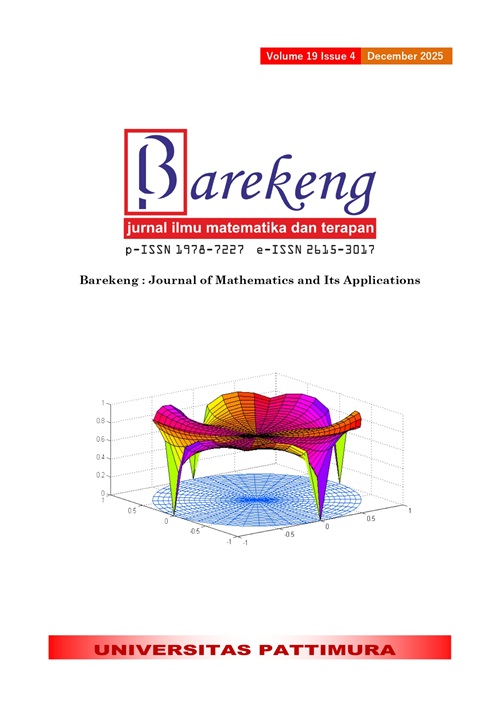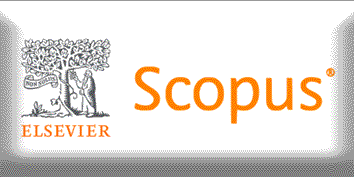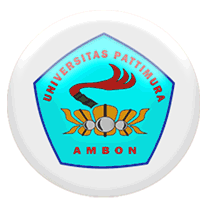THE LOCATING RAINBOW CONNECTION NUMBERS OF LOLLIPOP AND BARBELL GRAPHS
Abstract
The concept of the locating rainbow connection number of a graph is an innovation in graph coloring theory that combines the concepts of rainbow vertex coloring and partition dimension on graphs. This concept aims to determine the smallest positive integer such that there exists a locating rainbow -coloring on the graph, ensuring that every vertex has a unique rainbow code. In this study, we investigate the locating rainbow connection number of the lollipop graph and barbell graph . Using a literature study method, hypotheses were formulated and proven through theoretical analysis. The results show that and .
Downloads
References
A. W. Bustan, A. N. M. Salman, and P. E. Putri, “ON THE LOCATING RAINBOW CONNECTION NUMBER OF A GRAPH,” in Journal of Physics: Conference Series, IOP Publishing, 2021, p. 12057.doi: https://doi.org/10.1088/1742-6596/1764/1/012057
G. Chartrand, E. Salehi, and P. Zhang, “THE PARTITION DIMENSION OF A GRAPH,” Aequationes Math., vol. 59, no. 1, pp. 45–54, 2000.doi: https://doi.org/10.1007/PL00000127
M. Krivelevich and R. Yuster, “THE RAINBOW CONNECTION OF A GRAPH IS (AT MOST) RECIPROCAL TO ITS MINIMUM DEGREE,” J. Graph Theory, vol. 63, no. 3, pp. 185–191, 2010.doi: https://doi.org/10.1002/jgt.20418
G. Chartrand, G. L. Johns, K. A. McKeon, and P. Zhang, “RAINBOW CONNECTION IN GRAPHS,” Math. Bohem., vol. 133, no. 1, pp. 85–98, 2008.doi: https://doi.org/10.21136/MB.2008.133947
S. Chakraborty, E. Fischer, A. Matsliah, and R. Yuster, “HARDNESS AND ALGORITHMS FOR RAINBOW CONNECTION,” J. Comb. Optim., vol. 21, pp. 330–347, 2011.doi: https://doi.org/10.1007/s10878-009-9250-9
S. Ismail, I. K. Hasan, T. Sigar, and S. K. Nasib, “RAINBOW CONNECTION NUMBER AND TOTAL RAINBOW CONNECTION NUMBER OF AMALGAMATION RESULTS DIAMOND GRAPH ([Br] _4) AND FAN GRAPH (F_3),” BAREKENG J. Ilmu Mat. Dan Terap., vol. 16, no. 1, pp. 23–30, 2022.doi: https://doi.org/10.30598/barekengvol16iss1pp023-030
D. Fitriani, A. N. M. Salman, and Z. Y. Awanis, “RAINBOW CONNECTION NUMBER OF COMB PRODUCT OF GRAPHS.,” Electron. J. Graph Theory Appl., vol. 10, no. 2, 2022.doi: https://doi.org/10.5614/ejgta.2022.10.2.9
D. Welyyanti, L. A. Abel, and L. Yulianti, “THE LOCATING CHROMATIC NUMBER OF CHAIN (A, 4, n) GRAPH,” BAREKENG J. Ilmu Mat. dan Terap., vol. 19, no. 1, pp. 353–360, 2025.doi: https://doi.org/10.30598/barekengvol19iss1pp353-360
W. O. Asmiati and L. Z. Notiragayu, “UPPER BOUNDS OF THE LOCATING CHROMATIC NUMBERS OF SHADOW CYCLE GRAPHS,” Int. J. Math. Comput. Sci., vol. 19, no. 1, pp. 239–248, 2024.
G. Chartrand, D. Erwin, M. A. Henning, P. J. Slater, and P. Zhang, “GRAPHS OF ORDER N WITH LOCATING-CHROMATIC NUMBER N− 1,” Discrete Math., vol. 269, no. 1–3, pp. 65–79, 2003.doi: https://doi.org/10.1016/S0012-365X(02)00829-4
L. Chen, X. Li, and Y. Shi, “THE COMPLEXITY OF DETERMINING THE RAINBOW VERTEX-CONNECTION OF A GRAPH,” Theor. Comput. Sci., vol. 412, no. 35, pp. 4531–4535, 2011.doi: https://doi.org/10.1016/j.tcs.2011.04.032
L. Chen, X. Li, and H. Lian, “FURTHER HARDNESS RESULTS ON THE RAINBOW VERTEX-CONNECTION NUMBER OF GRAPHS,” Theor. Comput. Sci., vol. 481, pp. 18–23, 2013.doi: https://doi.org/10.1016/j.tcs.2013.02.012
M. I. N. Annadhifi, R. Adawiyah, D. Dafik, and I. N. Suparta, “RAINBOW VERTEX CONNECTION NUMBER OF BULL GRAPH, NET GRAPH, TRIANGULAR LADDER GRAPH, AND COMPOSITION GRAPH (P_n [P_1]),” BAREKENG J. Ilmu Mat. dan Terap., vol. 18, no. 3, pp. 1665–1672, 2024.doi: https://doi.org/10.30598/barekengvol18iss3pp1665-1672
A. W. Bustan and A. N. M. Salman, “THE RAINBOW VERTEX-CONNECTION NUMBER OF STAR FAN GRAPHS,” CAUCHY J. Mat. Murni dan Apl., vol. 5, no. 3, pp. 112–116, 2018.doi: https://doi.org/10.18860/ca.v5i3.5516
N. I. Yahya, A. Fatmawati, N. Nurwan, and S. K. Nasib, “RAINBOW VERTEX-CONNECTION NUMBER ON COMB PRODUCT OPERATION OF CYCLE GRAPH (C_4) AND COMPLETE BIPARTITE GRAPH (K_ (3, N)),” BAREKENG J. Ilmu Mat. dan Terap., vol. 17, no. 2, pp. 673–684, 2023.doi: https://doi.org/10.30598/barekengvol17iss2pp0673-0684
A. W. Bustan and A. N. M. Salman, “THE RAINBOW VERTEX CONNECTION NUMBER OF STAR WHEEL GRAPHS,” in AIP Conference Proceedings, AIP Publishing, 2019.doi: https://doi.org/10.1063/1.5141660
A. W. Bustan, A. N. M. Salman, P. E. Putri, and Z. Y. Awanis, “ON THE LOCATING RAINBOW CONNECTION NUMBER OF TREES AND REGULAR BIPARTITE GRAPHS,” Emerg. Sci. J., vol. 7, no. 4, pp. 1260–1273, 2023.doi: https://doi.org/10.28991/ESJ-2023-07-04-016
A. W. Bustan, A. N. M. Salman, and P. E. Putri, “ON THE LOCATING RAINBOW CONNECTION NUMBER OF AMALGAMATION OF COMPLETE GRAPHS,” in Journal of Physics: Conference Series, IOP Publishing, 2023, p. 12004.doi: https://doi.org/10.1088/1742-6596/2543/1/012004
A. W. Bustan, A. N. M. Salman, and P. E. Putri, “DETERMINING THE LOCATING RAINBOW CONNECTION NUMBER OF VERTEX-TRANSITIVE GRAPHS,” arXiv Prepr. arXiv2403.06004, 2024.
M. Imrona, A. N. M. Salman, S. Uttunggadewa, and P. E. Putri, “ON THE LOCATING RAINBOW CONNECTION NUMBER OF THE COMB PRODUCT WITH COMPLETE GRAPHS OR TREES,” in Southeastern International Conference on Combinatorics, Graph Theory, and Computing, Springer, 2021, pp. 203–214.doi: https://doi.org/10.1007/978-3-031-52969-6_18
Copyright (c) 2025 Ariestha Widyastuty Bustan, Taufan Talib, Novita Serly Laamena, Lamanisa Rasid Saputra, Nurhayati Nurhayati

This work is licensed under a Creative Commons Attribution-ShareAlike 4.0 International License.
Authors who publish with this Journal agree to the following terms:
- Author retain copyright and grant the journal right of first publication with the work simultaneously licensed under a creative commons attribution license that allow others to share the work within an acknowledgement of the work’s authorship and initial publication of this journal.
- Authors are able to enter into separate, additional contractual arrangement for the non-exclusive distribution of the journal’s published version of the work (e.g. acknowledgement of its initial publication in this journal).
- Authors are permitted and encouraged to post their work online (e.g. in institutional repositories or on their websites) prior to and during the submission process, as it can lead to productive exchanges, as well as earlier and greater citation of published works.






1.gif)



